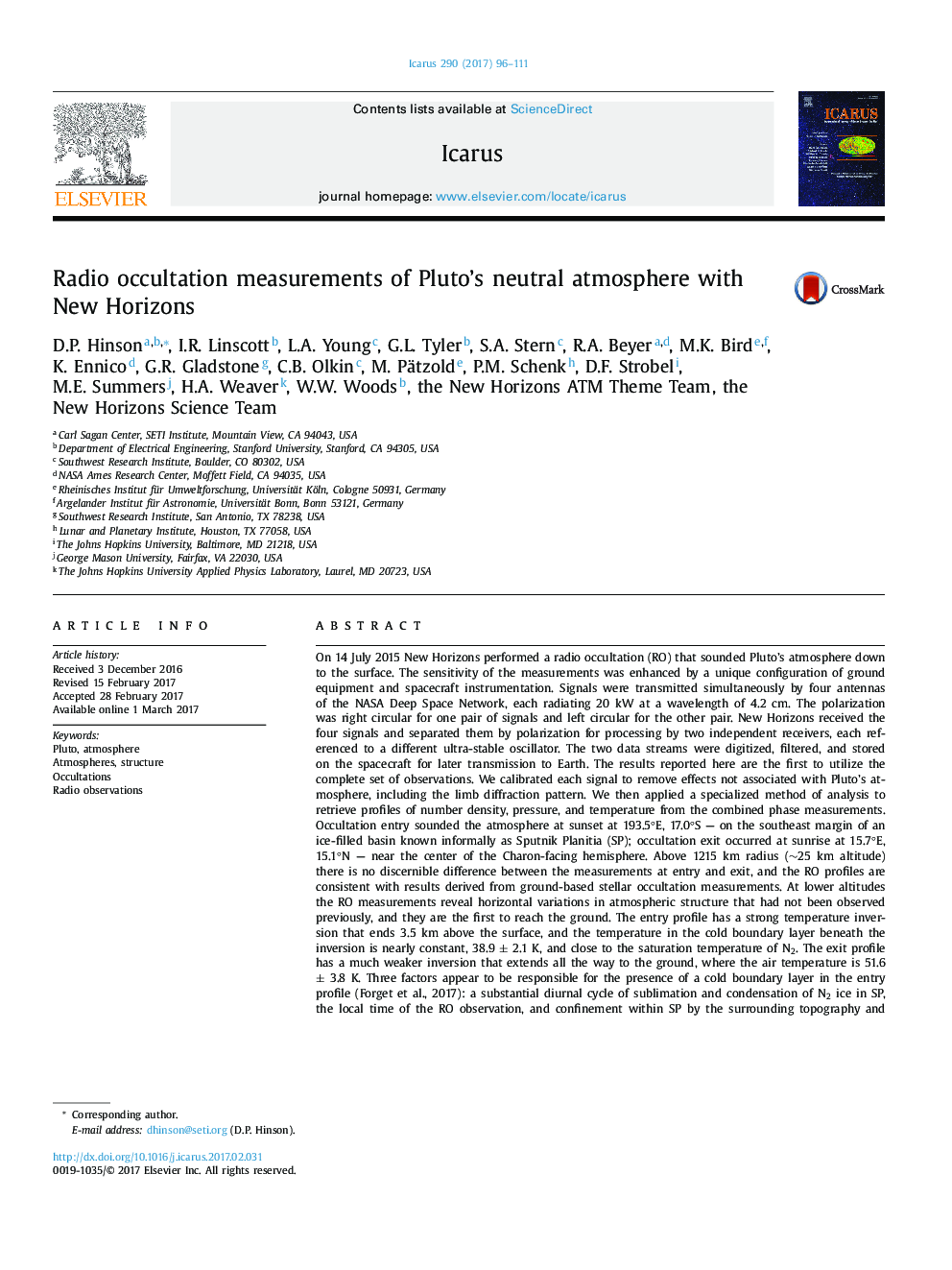| کد مقاله | کد نشریه | سال انتشار | مقاله انگلیسی | نسخه تمام متن |
|---|---|---|---|---|
| 5487037 | 1523501 | 2017 | 16 صفحه PDF | دانلود رایگان |
عنوان انگلیسی مقاله ISI
Radio occultation measurements of Pluto's neutral atmosphere with New Horizons
ترجمه فارسی عنوان
اندازه گیری های محاصره رادیویی از فضای خنثی پلوتو با افق های جدید
دانلود مقاله + سفارش ترجمه
دانلود مقاله ISI انگلیسی
رایگان برای ایرانیان
کلمات کلیدی
پلوتو، فضا، اتمسفر، ساختار، وقایع، مشاهدات رادیویی،
موضوعات مرتبط
مهندسی و علوم پایه
علوم زمین و سیارات
علوم فضا و نجوم
چکیده انگلیسی
On 14 July 2015 New Horizons performed a radio occultation (RO) that sounded Pluto's atmosphere down to the surface. The sensitivity of the measurements was enhanced by a unique configuration of ground equipment and spacecraft instrumentation. Signals were transmitted simultaneously by four antennas of the NASA Deep Space Network, each radiating 20 kW at a wavelength of 4.2 cm. The polarization was right circular for one pair of signals and left circular for the other pair. New Horizons received the four signals and separated them by polarization for processing by two independent receivers, each referenced to a different ultra-stable oscillator. The two data streams were digitized, filtered, and stored on the spacecraft for later transmission to Earth. The results reported here are the first to utilize the complete set of observations. We calibrated each signal to remove effects not associated with Pluto's atmosphere, including the limb diffraction pattern. We then applied a specialized method of analysis to retrieve profiles of number density, pressure, and temperature from the combined phase measurements. Occultation entry sounded the atmosphere at sunset at 193.5°E, 17.0°S - on the southeast margin of an ice-filled basin known informally as Sputnik Planitia (SP); occultation exit occurred at sunrise at 15.7°E, 15.1°N - near the center of the Charon-facing hemisphere. Above 1215 km radius (â¼25 km altitude) there is no discernible difference between the measurements at entry and exit, and the RO profiles are consistent with results derived from ground-based stellar occultation measurements. At lower altitudes the RO measurements reveal horizontal variations in atmospheric structure that had not been observed previously, and they are the first to reach the ground. The entry profile has a strong temperature inversion that ends 3.5 km above the surface, and the temperature in the cold boundary layer beneath the inversion is nearly constant, 38.9 ± 2.1 K, and close to the saturation temperature of N2. The exit profile has a much weaker inversion that extends all the way to the ground, where the air temperature is 51.6 ± 3.8 K. Three factors appear to be responsible for the presence of a cold boundary layer in the entry profile (Forget et al., 2017): a substantial diurnal cycle of sublimation and condensation of N2 ice in SP, the local time of the RO observation, and confinement within SP by the surrounding topography and katabatic winds. We have also determined the surface pressure and the local radius at both entry and exit. The best pressure reference is the mean value: 11.5 ± 0.7 microbar at 1189.9 ± 0.2 km.
ناشر
Database: Elsevier - ScienceDirect (ساینس دایرکت)
Journal: Icarus - Volume 290, 1 July 2017, Pages 96-111
Journal: Icarus - Volume 290, 1 July 2017, Pages 96-111
نویسندگان
D.P. Hinson, I.R. Linscott, L.A. Young, G.L. Tyler, S.A. Stern, R.A. Beyer, M.K. Bird, K. Ennico, G.R. Gladstone, C.B. Olkin, M. Pätzold, P.M. Schenk, D.F. Strobel, M.E. Summers, H.A. Weaver, W.W. Woods,
